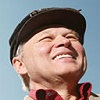18.2: Ejemplo de una especie
- Page ID
- 53135
Para ver la idea básica, comience con una sola especie. Con parámetros variables, el crecimiento poblacional para una sola especie puede escribirse de la siguiente manera, con la tasa de crecimiento\(r\) y el término de dependencia de la densidad\(s\) dependiendo del nivel poblacional\(N\) y opcionalmente del tiempo\(t\).
\[\frac{1}{N}\frac{dN}{dt}\,=\,r(N,t)\,+\,s(N,t)N\]
Debido a que cualquier cosa se puede incrustar en el término\(r(N,t)\), o en el correspondiente\(s(N,t)\), la ecuación es perfectamente general y puede cubrir cualquier situación ecológica para una sola especie modelada por una ecuación diferencial. Un ejemplo básico, que ya has visto para el crecimiento de la población humana, es donde los parámetros son aproximadamente constantes por largos periodos, pero cambian en ciertos eventos de “bifurcación”. Los parámetros para el crecimiento de la población humana cambiaron abruptamente al inicio de la era moderna, dando como resultado una dinámica poblacional general que no era ni ortóloga ni logística, sino una combinación por partes de ambas. En ese caso los dos se mezclaron variando los parámetros de la siguiente manera.
\(\frac{1}{N}\frac{dN}{dt}\,=\begin{cases}-&0.001185\,&+\,0.00684N,\,&\text{when}\,N\leq\,3.28\,\text{billion}\\&0.03077\,&-\,0.00289N,\,&\text{when}\,N\gt\,3.28\,\text{billion}\end{cases}\)
Esto condujo a la curva de crecimiento poblacional de la Figura 6.3, que modeló muy bien el crecimiento de la población humana a lo largo de los siglos
El crecimiento de la población humana requiere una mezcla por partes de los parámetros, ya que los parámetros cambiaron abruptamente de un conjunto constante a otro. Los parámetros también se pueden mezclar continuamente para parámetros que cambian gradualmente.
Por ejemplo, tomar una ecuación ortóloga\(1/N\,dN/dt\,=\,−2+2N\),, y una ecuación logística\(1/N\,dN/dt\,=\,4−2N\), y considerar\(N\) como va de 0 a 1. Haga que la ecuación ortóloga se aplique exactamente como\(N\) se acerca a 0, y la ecuación logística se aplique exactamente cuando N llegue a 1. Luego vamos a\(r\) cambiar uniformemente de −2 a +4 y\(s\) cambiar uniformemente de +2 a −2 como\(N\) va de 0 a 1, de la siguiente manera.
\(r(N,t)\,=6N-2\\s(N,t)\,=-4N+2\)
Conectarlo a la Ecuación 18.1 da
\[\begin{align}\frac{1}{N}\frac{dN}{dt}&=\,(6N-2)\,+\,(-4N+2)N\\&\,=\,-2\,+\,8N\,-4N^2\\&\,=\,r\,+\,sN\,=s_2N^2\end{align}\]
Este tipo de mezcla entre ortólogo y logística simplemente ha agregado un término más a la ecuación de crecimiento poblacional, un\(N^2\) término, uno de los términos propuestos por Hutchinson (Ecuación 4.2). El resultado se grafica en la Figura\(\PageIndex{1}\).
Esto fusiona suavemente el ortólogo, que tiene un punto Allee pero sin capacidad de carga, con el logístico, que tiene una capacidad de carga sin punto Allee, proporcionando ambos en la curva mezclada de Figura\(\PageIndex{1}\). La curva tiene un punto Allee aproximadamente\(N\,=\,0.3\) y una capacidad de carga aproximadamente\(N\,=\,1.7\). Compare esto con la mezcla por partes representada anteriormente en la Figura 4.4.


